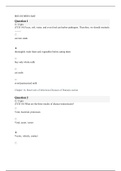Exam (elaborations)
Sarah Michelle FNP Practice Test QUESTIONS & ANSWERS Already GRADED A
- Course
- Institution
Sarah Michelle FNP Practice Test QUESTIONS & ANSWERS Already GRADED A-1. 1. Question A 65 year old female patient presents today to the clinic with worsening back pain over the last week. She appears to be sweating and states that she is profusely dizzy. Which of the following findings on her urin...
[Show more]





